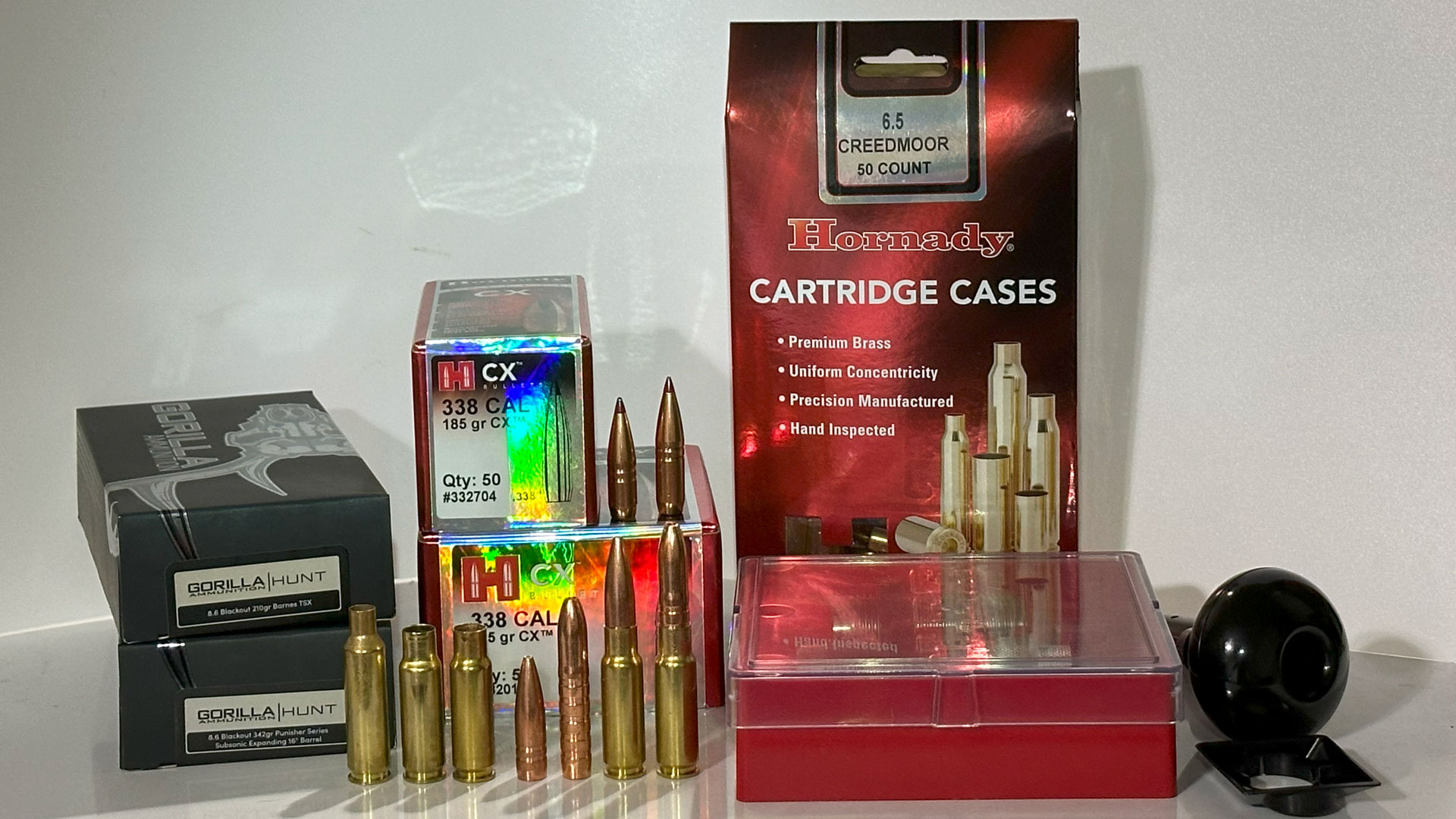
In one of my prior articles, I discussed two not-so-niche cartridges: the .243 Winchester and the 6mm Creedmoor. As you’ve probably guessed by now, I tend to go to extremes (it’s unintentional, I swear). This go around, we’re swinging for the fences on niche rounds: the new 8.6 Blackout (BLK) and the .338 Federal.
Let’s start with what the two rounds have in common. Each cartridge fires the same caliber bullet—both shoot .338-diameter projectiles. The two respective rounds also feed from a short-action, non-magnum rifle, meaning they can run in your average bolt gun, as well as feed through a semi-automatic like an AR-10. This means ammo capacity is equal in a magazine. Those similarities are about where the parallels stop.
For those not into cult followings of cartridges, the .338 Federal has the commercial backing of Federal Premium (it was created with Sako in 2006), and the company makes two loads for the cartridge. The concept was simple: neck up a .308 to accept .338-caliber bullets. Easy enough. The cartridge pushes a 200-grain bullet to about 2,700 fps, which, oddly enough, most handloading data (per Hodgdon, Nosler, Hornady and Barnes data) can’t seem to beat that, and in fact come up short. That said, it’s an extremely effective cartridge for what it was intended to do, which was offer improved hunting capabilities over the .308 Win. This results in better ballistics due to its slightly heavier bullet weights and larger frontal surface area, which means slightly better penetration, more energy and a slightly bigger hole (all else being relatively equal).

What about the 8.6 BLK? Based on a shortened 6.5 Creedmoor, the 8.6 BLK is what the .338 Federal wishes it was; the .338 Federal, while a marginal improvement over the .308 Win., only has that one thing going for it, which is why the 8.6 BLK is gaining popularity. The 8.6 BLK was developed by Q—the company that made the Honey Badger—to do some truly unique things that the .338 Federal can’t do.
For starters, the .338 Federal can’t be used to shoot suppressed. Sure, you can put a .338-cal. suppressor on a .338-Federal-chambered barrel, but you won’t get the sound mitigation you would if the projectile was going subsonic since the .338 Federal can’t go subsonic (yes, it might technically be possible, but I have yet to see data to support that claim). That said, because of the 8.6 BLK’s shortened case, there is less powder capacity, and because the case is so short and the neck is long, long—and I mean really long—heavy bullets can be used without limitations imposed by magazine lengths, making it the perfect cartridge for suppressed shooting.

This shortened case also makes the 8.6 BLK ideal in short barrels, which for hunting is great, as shorter-barreled rifles are far more maneuverable in blinds and stands. Since there’s not much powder, the cartridge gets full combustion out of much shorter barrels with no loss in velocity. It also makes reloading for the cartridge ultra efficient; reloading data on Faxon Firearms website (that’s the only viable data I’ve found so far, as the cartridge is only a couple years old and isn’t SAAMI approved) says 35.8 grains of Accurate 1680 powder yields an 87-percent fill volume for the 8.6 BLK case. For you competition shooters out there, you’ll note that’s just a tad more than many of the small-caliber “BR” cartridges (6mm BR, 6.5mm BR), or just a couple grains less than the hot 6mm GT. Except you’re shooting a massive, all-copper bullet.
The mythical part of the cartridge, though, rests not in the cartridge itself, but in the twist rate of the 8.6 BLK’s barrel. Ever heard of a 1:3” twist rate? Didn’t think so. What’s so special about it? One word: Physics. Rotating bullets super-fast does some weird things when a projectile hits soft tissue due to lateral forces being applied—and multiplied—outward. In simple terms, increasing spin rate increases rotational energy, which translates into more tissue disruption. And that “all-copper” bullet thing I mentioned earlier? That’s important here, because bullets which tend to come apart under normal shooting conditions fragment even faster when spinning much faster than intended. Copper bullets? Because of their monolithic—meaning one piece of metal—design, by nature, can’t separate like a bullet that is comprised of multiple parts and pieces, especially when that bullet has any kind of soft metal, like lead, as a material used in its construction.

Taking these considerations into account, ammo options, while few, show promise as far as the round matching its claimed potential. For example, Gorilla Ammunition sent me two loads for testing: the 210-grain Barnes TSX load (MSRP: $54.99/Box of 20), which has an advertised velocity of nearly 2,000 fps out of a 12-inch barrel, and its new offering, a 342-grain subsonic hunting load—found in its “Punisher” line—which comes in at an advertised speed of 1,000 fps, and it, too, is intended for 16-inch barrels (also available for 8-inch/12-inch barrels; MSRP: $59.99/Box of 20). In total, Gorilla Ammunition offers 11 different rounds—a mix of which are designed for various barrel lengths as shown here, plus different quantities.

In my testing, I took a box of each of the two loads mentioned above and ran them through a 16-inch Remington 700 and got 2,116 fps from the 210-grain Barnes load, and just over 1,000 fps (1,002 fps to be exact) using the subsonic load. That first load turned in an RPM of over 500,000 (507,840) with the latter subsonic load churning out 240,000 RPM. With all that lateral force helping rip the bullet open as it spins through tissue (imagine the pulling sensation on a merry-go-round going at half a million RPM), velocity isn’t nearly as important as it once was in getting copper bullets to open. And therein lies the magic of the 8.6 BLK. Once that bullet opens, all those RPM are going to keep those sharp edges of the expanded bullet not just pushing tissue out of the way as it penetrates, but also lacerate tissue as it spins, causing a much different —and exponentially more detrimental—wound cavity.

As mentioned, Faxon Firearms has reloading data available, including rough velocity estimates for 8-, 12-, and 16-inch barrels. And while the cartridge is mostly designed for suppressor use, Faxon goes so far as to also highlight some unique, ultralight super-sonic load data using a Barnes 160-grain TTSX bullet, which out of a 16-inch barrel can reach 2,400 fps if one is looking for more speed for a flatter trajectory.
After assessing the 8.6 BLK, for these reasons—suppressor use, efficiency and sheer terminal damage—I’d make the strong argument that the new 8.6 BLK outperforms the .338 Federal, especially for a hunter’s needs.



































